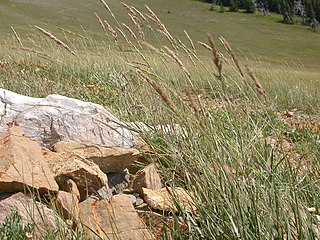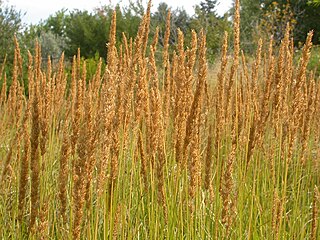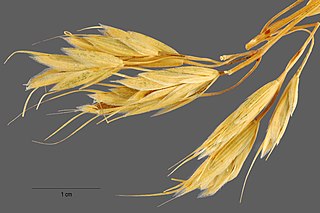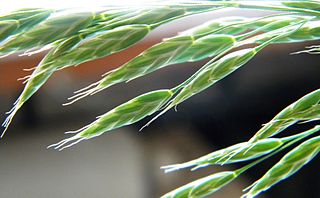
The marbled godwit is a large migratory shorebird in the family Scolopacidae. On average, it is the largest of the four species of godwit.

The spur-winged goose is a large, Sub-Saharan African waterbird in the family Anatidae, which includes geese and shelducks. However, P. gambensis developed unique environmental adaptations, which resulted in the evolution of several anatomical features that are not shared with other anatids; thus, the species has been classified one step further into its own subfamily, the Plectropterinae.

The vicuña or vicuna is one of the two wild South American camelids, which live in the high alpine areas of the Andes, the other being the guanaco, which lives at lower elevations. Vicuñas are relatives of the llama, and are now believed to be the wild ancestor of domesticated alpacas, which are raised for their coats. Vicuñas produce small amounts of extremely fine wool, which is very expensive because the animal can only be shorn every three years and has to be caught from the wild. When knitted together, the product of the vicuña's wool is very soft and warm. The Inca valued vicuñas highly for their wool, and it was against the law for anyone but royalty to wear vicuña garments; today, the vicuña is the national animal of Peru and appears on the Peruvian coat of arms.

Calamagrostis purpurascens, is a perennial grass commonly known as purple reedgrass, purple pinegrass, or alpine reedgrass.

Calamagrostis epigejos, common names wood small-reed or bushgrass, is a species of grass in the family Poaceae which is native to Eurasia and Africa. It is found from average moisture locales to salt marsh and wet habitats.

Lagurus is a genus of Old World plants in the grass family, native to the Mediterranean Basin and nearby regions, from Madeira and the Canary Islands to Crimea and Saudi Arabia. It is also naturalized in Australia, New Zealand, the Azores, Ireland and Great Britain, and scattered locations in the Americas. The only known species is Lagurus ovatus, commonly called hare's-tail, hare's-tail grass or bunnytail. It is also grown as an ornamental plant for its attractive flower panicles.

Bromus hordeaceus, the soft brome, is an annual or biennial species of grass in the grass family (Poaceae). It is also known in North America as bull grass, soft cheat, and soft chess.

Calamagrostis arundinacea is a species of bunch grass in the family Poaceae, native to Eurasia, China and India. Under its synonym Calamagrostis brachytricha it has gained the Royal Horticultural Society's Award of Garden Merit.

Calamagrostis stricta, known as slim-stem small reed grass or narrow small-reed, is a species of bunchgrass in the family Poaceae of the Holarctic Kingdom.

Bromus ciliatus is a species of brome grass known by the common name fringed brome. It is native to most of North America, including most of Canada, most of the United States except for some portions of the South, and northern Mexico. It is a plant of many habitats, including temperate coniferous forest. The specific epithet ciliatus is Latin for "ciliate", referring to the delicate hairs of the leaf blades.

Calamagrostis koelerioides, the fire reedgrass, dense-pine reedgrass, or the pineland reed grass, is a species of grass in the family Poaceae native to western North America. It ranges from western Wyoming to Washington state, south to Mexico. It is found in many habitat types, including mountain meadows, chaparral, pine and spruce forests, and on slopes, dry hills, and ridges.

San Guillermo National Park is a national park in Argentina, in the Iglesia Department of San Juan Province. It was established in 1998 and is part of the San Guillermo Biosphere Reserve. Elevations in the biosphere range from 2,100 metres (6,900 ft) to 6,380 metres (20,930 ft). Vegetation in the National Park and biosphere consists of barren desert, grasslands, and a few wetlands, all located in the high, arid Andes. The animals include vicuña, guanaco, culpeo fox, Andean mountain cat, cougar, and Andean condor.
Asana River is a waterway in the Moquegua Region of southern Peru. It is one of the tributaries of the Osmore River. The Asana archaeological site, occupied over the course of 8,000 years, is situated in a basin on the river's north bank. The Quellaveco mining project sought to divert the Asana for extractive waste material placement in its copper mining operations.

Bromus squarrosus, the rough brome, is a brome grass native to Russia and Europe. The specific epithet squarrosus is Latin, meaning "with spreading tips". The grass has a diploid number of 14.

Festuca brachyphylla, commonly known as alpine fescue or short-leaved fescue, is a grass native to Eurasia, North America, and the Arctic. The grass is used for erosion control and revegetation. The specific epithet brachyphylla means "short-leaved". The grass has a diploid number of 28, 42, or 44. This species was first described in 1827.

Festuca saximontana, the rocky mountain fescue or the mountain fescue, is a perennial grass native to North America. The specific epithet saximontana is Latin and means "of the Rocky Mountains". The grass has a diploid number of 42.
Calamagrostis intermedia is a species of grass in the family Poaceae. It is native to South America, growing in high elevation grasslands and forest clearings. Its range extends from Colombia to Argentina.

Calamagrostis tweedyi, the Cascade reedgrass or Tweedy's reedgrass, is a perennial in the grass family. It is native to the Pacific Northwest in the United States, in Washington, Oregon, Idaho, and Montana.

Bromus racemosus, the smooth brome or bald brome, is a species of flowering plant in the family Poaceae. It is native to subarctic and temperate Eurasia, and widely introduced elsewhere, including North America, Iceland, the Southern Cone of South America, the Korean Peninsula, Australia, and New Zealand. It grows in alkaline meadows and in waste places.

Vicuña wool refers to the hair of the South American vicuña, an animal of the family of camelidae. The wool has, after shahtoosh, the second smallest fiber diameter of all animal hair and is the most expensive legal wool.

















